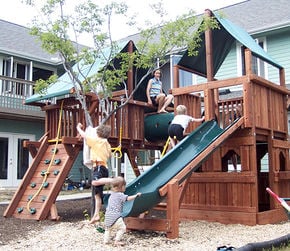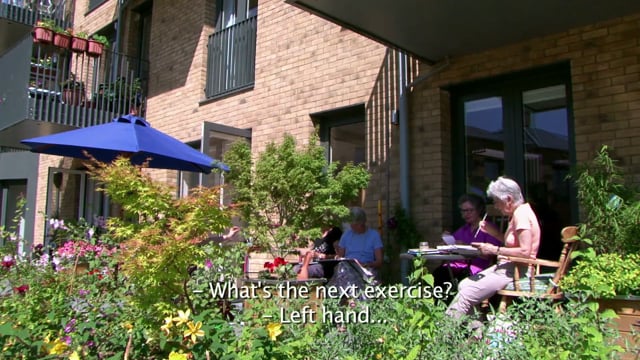
 A model for senior living? London’s commune for older women, positive.news (Jun 14, 2023)
A model for senior living? London’s commune for older women, positive.news (Jun 14, 2023)
Cohousing is a way of sharing resources and space, and allowing for greater community and collaboration, while still giving individuals their own private space - though less private space is needed than in conventional, isolated housing.
Cohousing is an intentional community of private homes clustered around shared space. The term originated in Denmark in the late 1960s. Each attached or single-family home has traditional amenities, including a private kitchen. Shared spaces typically feature a common house, which may include a large kitchen and dining area, laundry, and recreational spaces. Shared outdoor space may include parking, walkways, open space, and gardens. Neighbors also share resources like tools and lawnmowers.
Households have independent incomes and private lives, but neighbors collaboratively plan and manage community activities and shared spaces. The legal structure is typically a homeowner association or housing cooperative. Community activities feature regularly scheduled shared meals, meetings, and workdays. Neighbors gather for parties, games, movies, or other events. Cohousing makes it easy to form clubs, organize child and elder care, and carpool.
Cohousing facilitates interaction among neighbors and thereby provides social, practical, economic, and environmental benefits.
Cohousing in Denmark
Sættedammen is a cohousing community in Denmark. Established 1972, it is the world's first cohousing community. The membership comprises approximately 60 adults and 20 children in 35 households. Sættedammen is an open, non-dogmatic community, based on social activities (various interest groups, a daily common dinner, common celebration of holidays and cultural events).
The modern theory of cohousing originated in Denmark in the 1960s among groups of families who were dissatisfied with existing housing and communities that they felt did not meet their needs. Bodil Graae wrote a newspaper article titled "Children Should Have One Hundred Parents", spurring a group of 50 families to organize around a community project in 1967. This group split into two groups who developed the cohousing projects Sættedammen and Skråplanet, which are the oldest known modern cohousing communities. The key organizer was Jan Gudmand Høyer who drew inspiration from his architectural studies at Harvard and interaction with experimental U.S. communities of the era. He published the article "The Missing Link between Utopia and the Dated Single Family House" in 1968, converging a second group.
Hundreds of cohousing communities exist in Denmark and other countries in northern Europe. W
Cohousing in the Netherlands
There are more than 300 cohousing communities in the Netherlands (73 mixed-generation and 231 senior cohousing), with about 60 others in planning or construction phases. W
Cohousing in Spain
Cohousing in the UK
Cohousing started to develop in the UK at the end of the 1990s. The movement has gradually built up momentum and there are now 14 purpose built cohousing communities. A further 40+ cohousing groups are developing projects and new groups are forming all the time. Cohousing communities in the UK range from around 8 households to around 30 households. Most communities are mixed communities with single people, couples and families but some are only for people over 50 and one is only for women over 50 years. The communities themselves range from new developments built to modern eco standards to conversions of everything from farms to Jacobean mansions to former hospital buildings and are in urban, rural and semi- rural locations. W
Cohousing in Canada
In Canada, there are 17 completed communities, and approximately 42 in the forming, development, or construction phase (see The Canadian Cohousing Network). W
Cohousing in the United States
Cohousing communities are part of the new cooperative economy in the United States and are predicted to expand rapidly in the next few decades as individuals and families seek to live more sustainably, and in community with neighbors. Since the first cohousing community was completed in the U.S. – Muir Commons in Davis, California – more than 160 communities have been established in 25 states plus the District of Columbia, with more than 125 in process. Most cohousing communities are intergenerational with both children and elders; in recent years, senior cohousing focused on older adult needs have grown. These communities come in a variety, but are often environment friendly and socially sustainable.
see also:
- Cambridge Cohousing
- Cohousing Association of the United States https://www.cohousing.org/
- https://www.schemataworkshop.com/passions-cohousing
- Takoma Village Cohousing
Cohousing in Oceania
There are also communities in Australia and New Zealand. W
News and comment
 Cohousing is empowering people to fight back against a global housing crisis, The Conversation (Nov 02, 2022)
Cohousing is empowering people to fight back against a global housing crisis, The Conversation (Nov 02, 2022)
See also
- Community land trust
- Towards a more democratic and climate friendly way of meeting housing need across England
- Housing UK news
- Housing affordability
- Housing cooperative
- Housing UK community action resources
- Land activism
- Land activism UK
- Community-led housing




